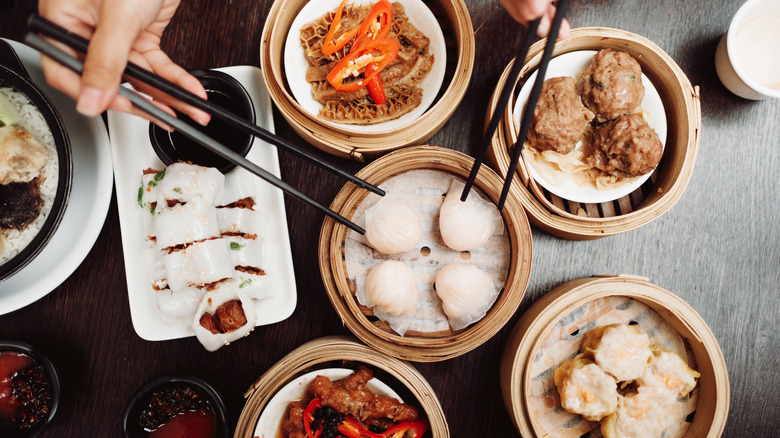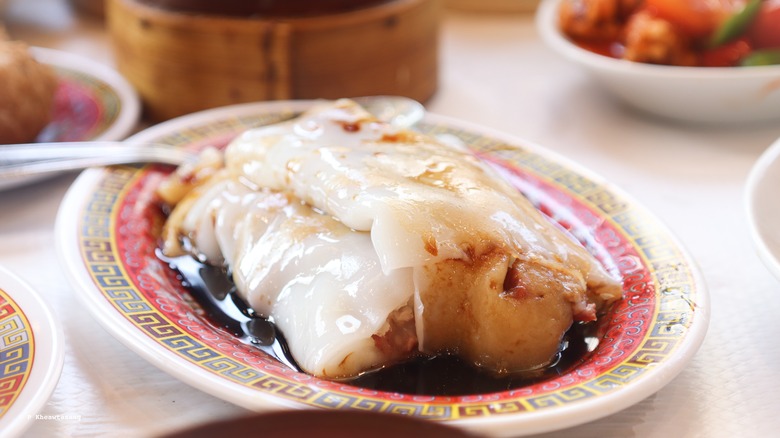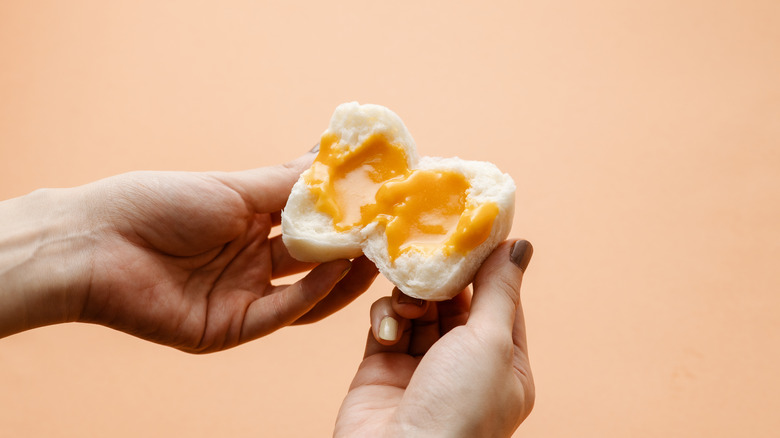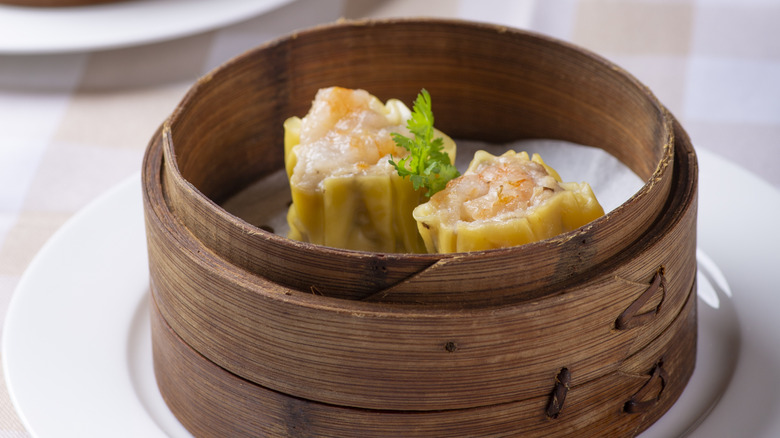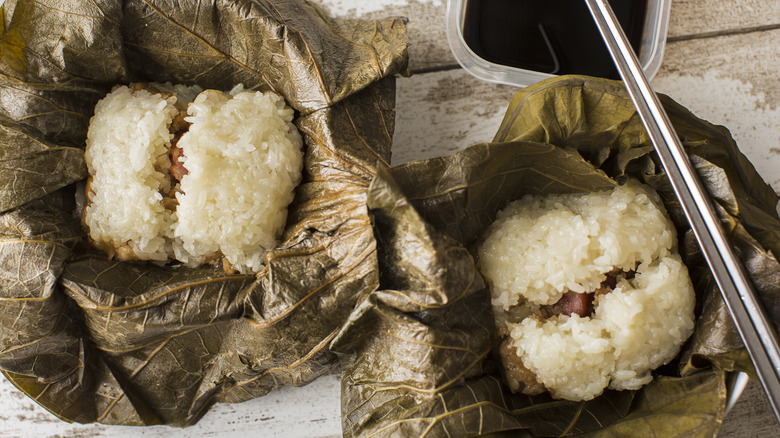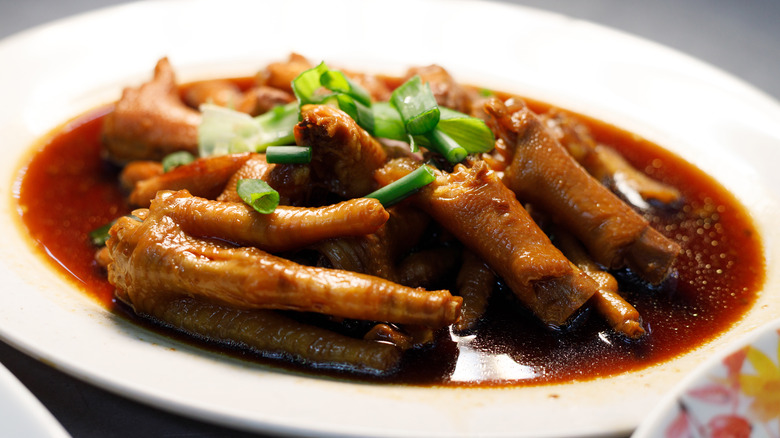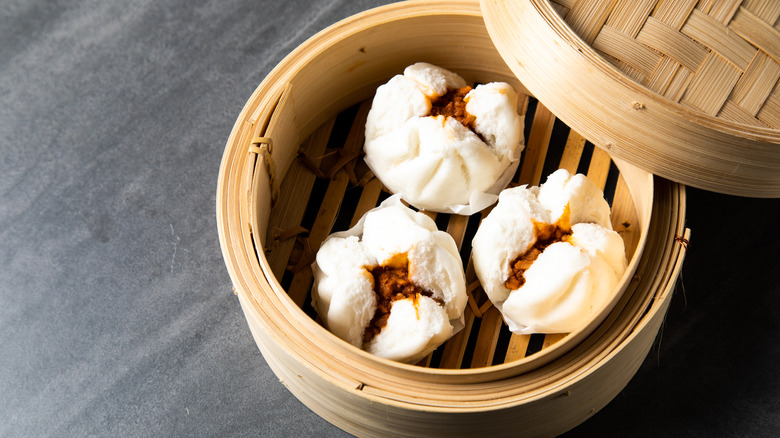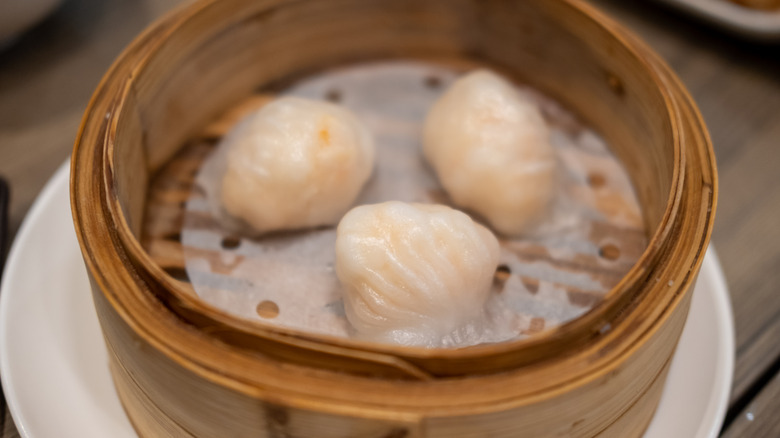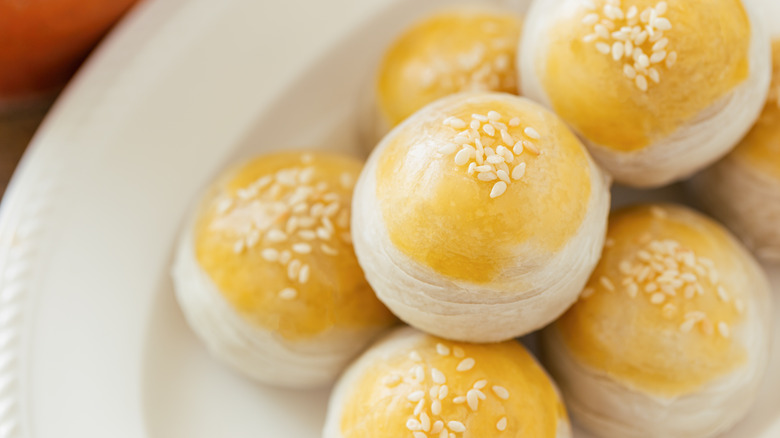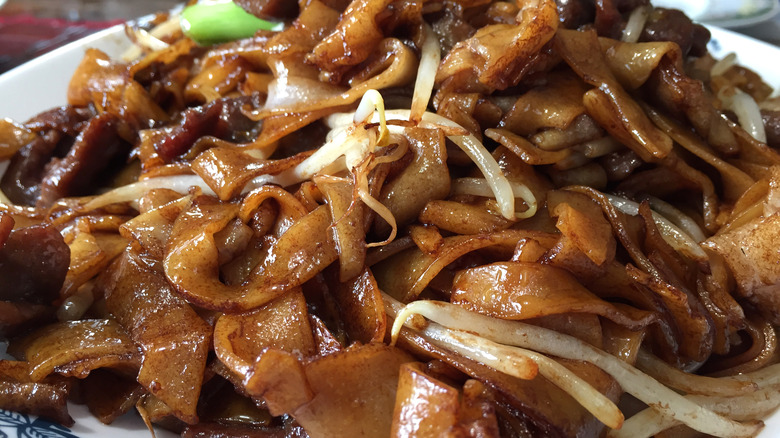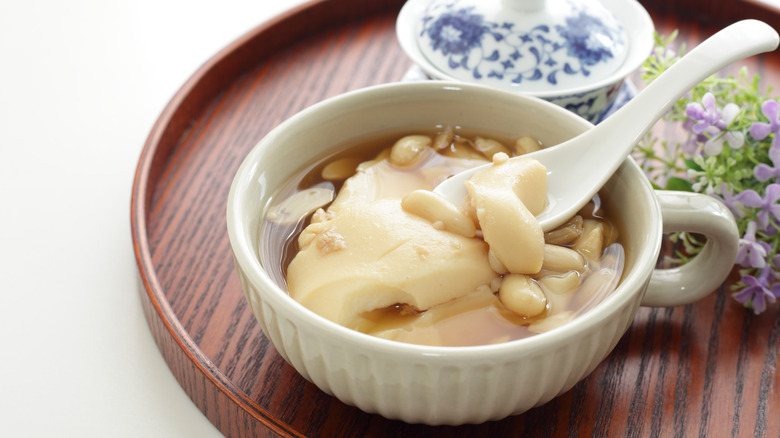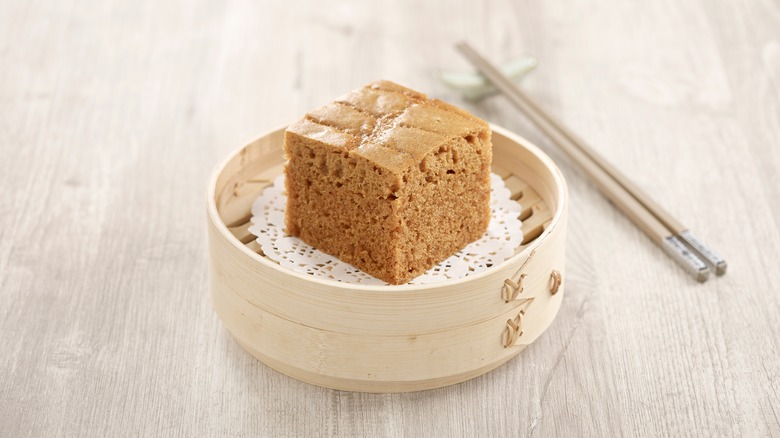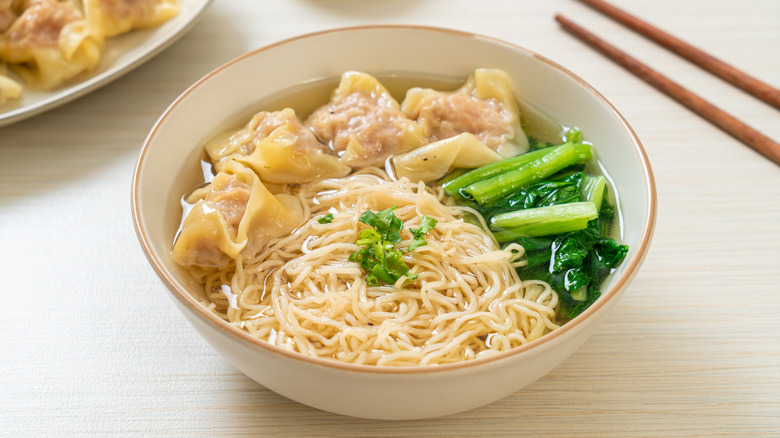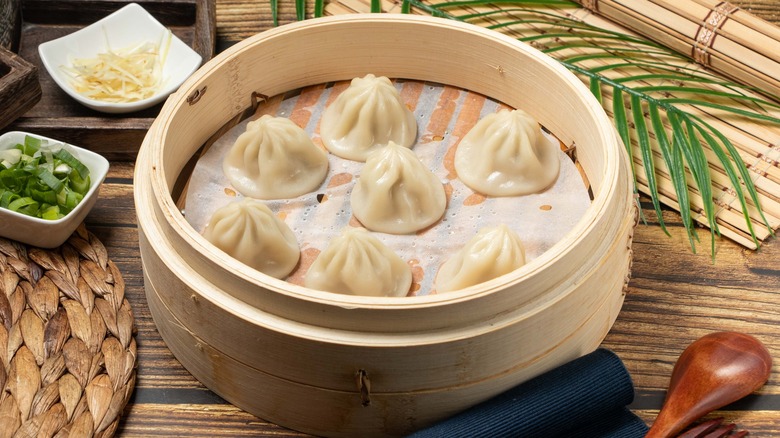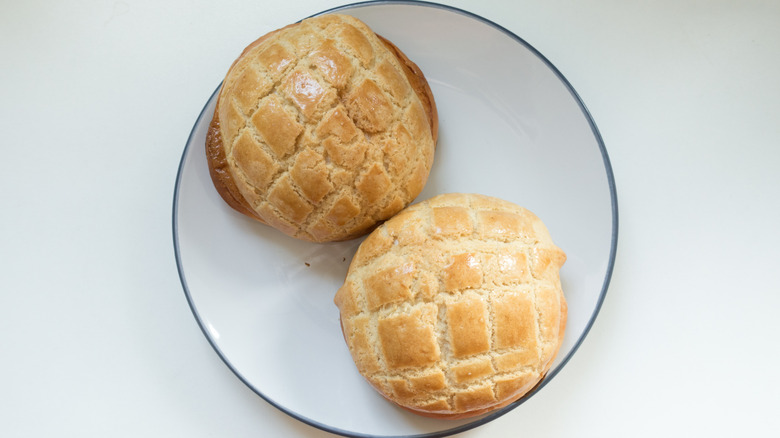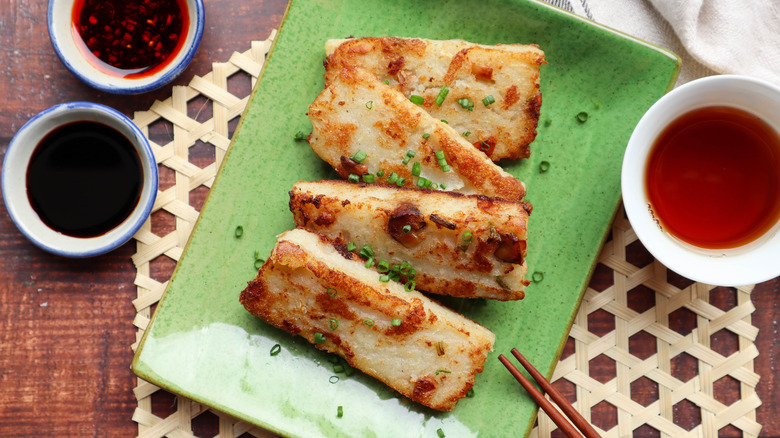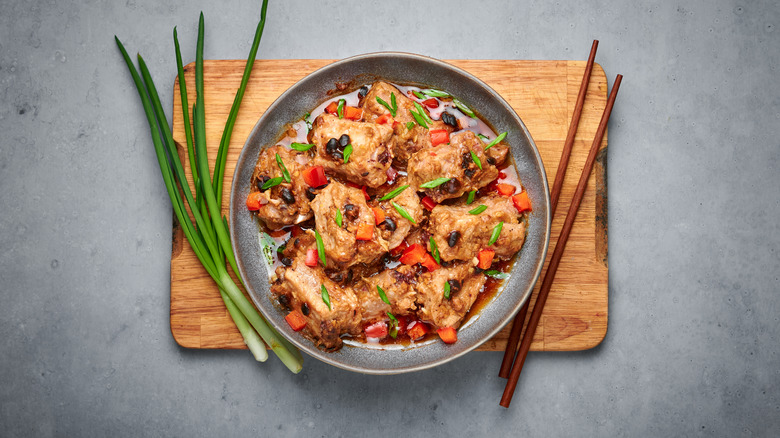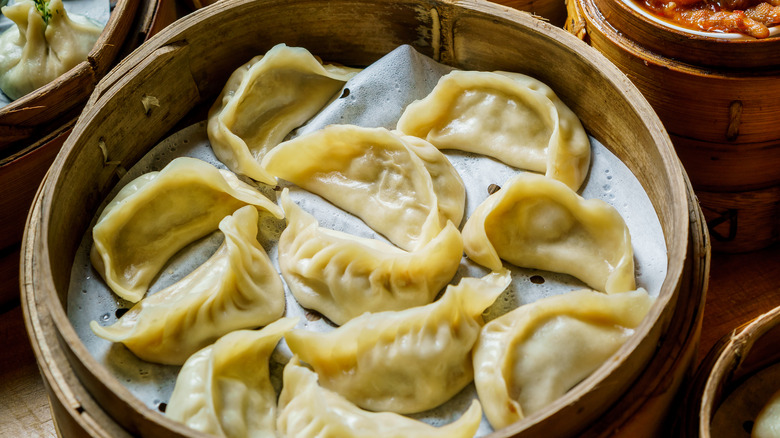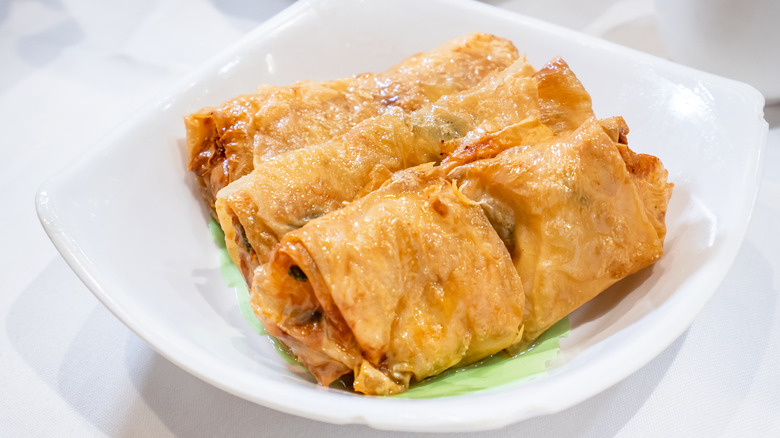18 Best Dim Sum Dishes You Need To Order
There are few dining experiences that are as fulfilling, and as varied, as having dim sum. Dim sum is southern Chinese in origin, with a lot of the dishes coming from the Guangdong region, and its distinctive dining style being developed over many years. The format of dim sum, a meal consisting of several different small plates accompanied by tea, started as a way to feed travelers moving along the Silk Road. It was in the 19th century, however, that dim sum started to become a more formal dining experience, gaining a foothold in Hong Kong. Gradually, dim sum restaurants started to spread throughout the world, and more and more people fell in love with the style, and all of the dishes at its core.
Dim sum is an enduringly popular style of eating. It is relaxed and communal. Like tapas, it's also a great way to sample a range of different dishes and flavors in one go. Dim sum is traditionally served from carts that are wheeled around the dining area, with tables picking up baskets and plates as they go past. Nowadays, dim sum experiences can be a little more similar to ordering in a regular restaurant. Whatever way you're grabbing your dishes, you're going to want to order well, making sure that you've got the widest variety of flavors, and not missing the best ones — that's where we come in.
1. Cheung fun
In our opinion, no dim sum meal is complete without a plate of cheung fun. This dish is served as a breakfast food in Hong Kong but was first developed in the early 20th century in Guangdong. Nowadays, it appears on dim sum menus worldwide, and is an enduring hit, thanks to its ultra-chewy texture.
Cheung fun is made from rice flour, which is rolled into a thick sheet and steamed. It's then wrapped around fillings like shrimp or pork and they're steamed together, and the whole thing is doused with a savory-sweet sauce. As such, it's an exercise in contrast, with the plain rice noodles serving as a base for the more intense flavors of the filling and liquid component. In some establishments, it can be pan-fried. We recommend ordering it alongside feng zhua or spare ribs.
2. Liu sha bao
Liu sha bao is a pretty recent invention, only becoming truly popular in the 2010s, but it's taken the dim sum world by storm. Yet despite this, its core component, salted egg yolks, has been around since the fifth century.
The dish consists of a steamed bao bun stuffed with a salted egg yolk, which has been mixed with butter and condensed milk. When bitten into, the bun oozes the salty-sweet, ultra-creamy yolk, while the fluffy dough helps to temper the intense flavor.
Liu sha bao first took off in Singapore and Hong Kong, before quickly becoming popular in dim sum restaurants elsewhere. As it's primarily sweet, the dish is best ordered towards the end of the meal, as a final course. It's particularly good if you've had a dim sum meal that's been dominated by ultra-savory flavors or vegetables.
3. Siu mai
Few dim sum dishes are as iconic as siu mai. These dumplings can be found on pretty much every dim sum menu worldwide. While they can vary in how they're made, they're typically identifiable by their open-faced construction and ground meat filling. Generally, siu mai are filled with pork and shrimp stuffing. A golden dumpling wrapper is folded around it, leaving the inside exposed on the top.
Siu mai is typically considered to be Cantonese. The dumplings' golden-colored wrapper comes from the inclusion of eggs and lye water in its recipe, which also give the siu mai an added richness. Siu mai is generally served in a steamed basket and is perfect with a sharp dipping sauce. It may also be topped with a variety of garnishes, from chopped chives to roe, or served on its own.
4. Lo mai gai
One of the most comforting dim sum dishes out there, lo mai gai is the complete package — quite literally. This dish is made by adding glutinous rice to a lotus leaf and topping it with a mixture of chicken, mushrooms, char siu, Chinese sausage, and salted egg yolk. Once it's topped with more rice, the lotus leaf is wrapped around the mixture and steamed.
This produces a fragrant dish, with the flavors melding together when it's cooked. Lo mai gai is thought to have originated in night markets in Guangzhou, where people would buy the packages to eat on the go — hence the lotus leaf wrapper. It quickly became popular and is now somewhat of a comfort food. As it's so beloved as dim sum, it's likely to pop up on the menu. Order it alongside sharper-flavored dishes or soups.
5. Feng zhua
Feng zhua is not for the unadventurous, but you'll be a fool to miss it if you're looking for authentic dim sum. Feng zhua (also known as Phoenix Claws) is chicken feet, which are double-cooked in a multitude of complex flavors. The feet are fried before being simmered in a sticky-sweet sauce that can include black beans and chili flakes, which allows them to soften up considerably.
While this might not sound appetizing to those unfamiliar with eating this part of the chicken, it's worth a try. When cooked in this method, chicken feet are surprisingly flavorful. They develop a super-soft, almost gelatinous consistency. This gives the whole dish a succulence that you just won't get from chicken breast. Feng zhua is best eaten with simple accompaniments like plain steamed rice or dumplings like jiaozi or cha siu bao.
6. Cha siu bao
The bao bun is a thing of beauty. These dumplings are an evolution of mantou (meaning "barbarian's heads"), an unfilled bun said to have been created by Zhuge Liang, the famed 3rd-century military leader. According to legend, Zhuge had 50 large mantou buns made to appease a Deity who was protecting a river and wanted the heads of Zhuge's soldiers. The leader threw the round buns in the river instead, granting Zhuge passage — and a culinary hero was born.
Cha siu bao is stuffed mantou, filled with sweet barbecue pork. The rice flour dough is wrapped around the sticky, moist filling, and the two are steamed together in a bamboo basket. As a result, the soft, pillowy dough offsets the sharpness of the filling, creating an excellent flavor balance. As cha siu bao can sometimes be dense, order it alongside slightly lighter dishes like steamed broccoli.
7. Har gow
This dumpling is instantly recognizable by its bright white dough, achieved by combining regular wheat flour with corn or tapioca starch. This combination of flours gives the dough a lightness that you don't get with wheat flour alone and gives it a striking visual appearance. Inside the dumplings is a filling of raw shrimp and seasonings, giving the interior a gentle, subtle flavor that matches its outward look.
Har gow was invented in a family-owned dim sum restaurant located near a river in Guangzhou, with the shrimp used in the filling sourced locally. Once other restaurants caught wind of the delicate, visually stunning dumplings, though, there was no stopping them. While har gow is definitely on the lighter side flavor-wise, try to enjoy it with a light dipping sauce at most, to properly appreciate its gentle tastes without overpowering it.
8. Char siu sou
Char siu sou is one of the best ways to enjoy the legendary tastes of char siu. This super-sweet roasted pork dish has an astonishingly lengthy history, first appearing in cookbooks approximately three millennia ago. As the years went on, char siu developed to take on different flavors and to be prized for its higher fat content. Nowadays, when prepared the meat is a fatty, glossy, bright-red affair, with the flavors of soy sauce, oyster sauce, spring onion, and sugar.
While you can enjoy char siu on its own or with rice, char siu sou instead sees the meat baked into the center of a flaky pastry. The neutral-tasting pastry helps to counteract the sharp pork in the same way that char siu bao does, giving it a blank flavor base to sit upon. Serving it in bun form also means it's easily eaten by hand.
9. Beef ho fun
While many dim sum dishes, like lo mai gai or cha siu bao, come in individually formed portions, beef ho fun takes a communal approach. This dish is a steaming pile of stir-fried noodles, beef, spring onions, and beansprouts, doused in a rich, dark soy sauce, and designed to be shared with your fellow diners. Instead of using egg or wheat noodles, beef ho fun uses rice noodles, which have a chewy and addictive mouthfeel, and the inclusion of high-protein beef makes it a filling choice.
Beef ho fun was developed, like many dim sum dishes, in Guangzhou. Allegedly, the dish was born of innovation, with a chef called Mr. Hui having to improvise a stir-fried noodle dish when a military commander requested something filling and saucy. Hui threw some dumpling sheets into the wok instead of regular noodles, and a modern classic was born.
10. Tau foo fah
Chinese cuisine uses tofu with versatility and innovation, but many folks may only be used to eating it as part of a plant-based stir fry. Tau foo fah, though, puts a sweet twist on tofu. This dish is a tofu pudding, made using soft silken tofu that's been drenched in flavored syrup. Also known as douhua, it may also be made with savory flavors. In Sichuan, for example, it can be served accompanied with Sichuan pepper and chili oil.
Tau foo fah has one of the oldest histories of any of the dishes you'll find on a dim sum menu. The dish was originally conceived during the Han dynasty and was a common after-dinner treat for Buddhist monks. Alongside being a common fixture in dim sum restaurants, tau foo fah can also be found on menus in other countries, including Indonesia, Malaysia, and the Philippines.
11. Ma lai go
The most famous dim sum dishes tend to be savory, but you shouldn't forget about the sweet options on offer too. One of the best, ma lai go, is also one of the simplest. Ma lai go is a steamed sponge cake made with brown sugar, evaporated milk, and vanilla flavorings. Once the batter has been whipped up, the cake is then often steamed in a bamboo steamer, before being cut into pieces and served.
In some dim sum restaurants, ma lai go begins with a fermented starter dough, which gives the cake more complexity and aeration. While the cake is now a Hong Kong staple, it was originally conceived in Malaysia, with the British presence in the region influencing its creation (which can be seen in its similarity to a British sponge cake). The translation of "ma lai go" even means "Malaysia cake."
12. Wonton noodles
Wonton noodles is a dim sum dish that has transcended the Hong Kong tea rooms to become ultra-popular as a meal in itself. But if you want the best version of it, you should order it during a dim sum service.
Wontons have been served in a soup since the 17th century, traditionally as a meal for wealthier individuals. It gained more popularity amongst a wider audience when it began being served more widely in Hong Kong around the Second World War, and soon became a dim sum staple.
While wonton soup can be pretty simple — consisting of simply wontons in a clear broth — wonton noodles bulk it out by adding more carbs. Thin egg noodles are usually used, which allow for greater maneuverability and stop the broth from splashing everywhere when you're fishing it out. Meat and vegetables like bok choy or mushrooms can also be added.
13. Xiao long bao
Xiao long bao is all the rage these days, but these soup dumplings have been around for a while. These buns were apparently created in Shanghai in the 1870s by restauranter Huang Mingxian. Seeking to make an impact in a crowded dumpling market, Mingxian devised a technique to make his bao buns moister than others, by including aspic. This jellied meat stock, when cooked, melts into a rich, savory broth, giving xiao long bao their soupy reputation.
Xiao long bao are generally stuffed with pork filling alongside the aspic, and then closed in a distinctive rounded shape, before being steamed. There's a knack to eating them to avoid the soup spilling down your top: Place the xiao long bao in a flat-bottomed spoon, and nibble a small hole in the side, allowing the soup to pour out. Then, spoon it into your mouth, and enjoy.
14. Bolo bao
Despite "bolo bao" meaning "pineapple bun," you might be surprised when you order it. This light, ever-so-slightly crusty bun contains no pineapple at all and is instead named for its appearance, with a cracked surface and a bright yellow sheen. Bolo bao has a sweet, milky flavor, with custard powder and eggs being common ingredients, which also contribute to its color.
Whether ordering one from a bakery or in a dim sum restaurant, bolo bao is often served cut in half, with a chunky slice of butter sandwiched between the slices. Elsewhere, though, it may have slightly less traditional fillings. While bolo bao is sweet, it can also go very well with savory ingredients like luncheon meat or even fried chicken.
15. Lo bak go
If you want to try the unexpected at a dim sum restaurant, order lo bak go. This dish is a turnip cake, made with shredded Chinese turnips or daikon radish mixed with rice flour or cornstarch. The choice of turnip gives it a gentle, lightly vegetal flavor, and the addition of Chinese sausage, mushrooms, and dried shrimp turns it into a savory delight. Once everything is mixed together, the cake is then steamed, cut into slices, and fried.
Lo bak go carries a lot of cultural significance, and is a common presence on dinner tables at New Year's celebrations, bringing good fortune. "White radish is also called 'choi tau' or 'cai tou' in some areas of China, which sounds like the words for 'good luck' in Chinese. So it's an auspicious cake," explains Hong Kong Baptist University's food culture and Chinese etymology expert Siu Yan Ho, per CNN.
16. Steamed spare ribs with black beans
Dim sum dishes can often be centered around, or include, carbohydrates like noodles or bao dough. But if you want something meaty, go for spare ribs with black beans. This ultra-savory dish tastes fresh and light despite using potentially heavy pork ribs, thanks to its cooking method: Steaming. The ribs are chopped and mixed with Shaoxing wine, sugar, salt, and white pepper, before being blanketed with chilies and fermented black beans. After being placed on individual plates, they're then steamed until tender.
This dish gets a significant amount of its flavor from the black beans used, which are fermented in salty water until they develop an intense, rich, funky taste. They impart a deep savoriness into the ribs and can do so without using huge amounts of fat or salt. Spare ribs with black beans are best served alongside plain steamed white rice.
17. Jiaozi
No dim sum is complete without Jiaozi. These individual parcels are pretty much the archetypal dumpling, and while they now appear in various forms around the globe (such as in Japan, as gyoza), they originated in Northern China. Jiaozi are instantly recognizable for their crescent shape, which is also similar to traditional Chinese currency. As a result, they're often associated with good fortune and luck and are served at significant moments in the year.
Jiaozi are usually filled with meat, but may also have vegetable stuffing. Unlike other dumplings, which typically only have one cooking style, jiaozi can be prepared in a number of ways. They may be steamed in a bamboo basket, pan-fried to give them a crispy bottom, or served in soup. When served dry, they're often accompanied with a dipping sauce and are best enjoyed with light sides, like fresh or pickled vegetables.
18. Tofu skin roll
Tofu skin may not be as well-known as regular firm tofu in the West, but it's a must-try in a dim sum setting. This delicacy has been eaten for hundreds of years in China and is made by boiling soy milk until a thin film appears over the top. The pliable film (which is the tofu skin) is then peeled away and dried, before being softened in water and prepared in restaurants.
A tofu skin roll is simply a stuffed tofu skin and is similar in appearance to a classic spring roll. Tofu skin rolls generally contain a ground pork filling, making this a high-protein appetizer, and are flavored with shiitake mushrooms, ginger, garlic, and seasonings. The rolls are then fried to give them a crispy outer coating and then steamed until cooked through. Some dim sum restaurants will also deep-fry their tofu skin rolls.
